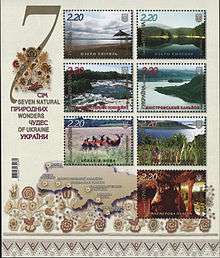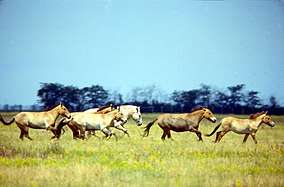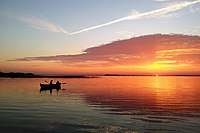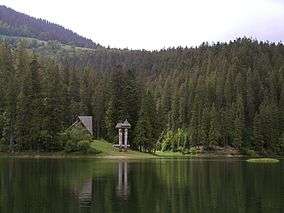Seven Natural Wonders of Ukraine
The Seven Natural Wonders of Ukraine (Ukrainian: Сім природніх чудес України, Sim pryrodnikh Tchudes Ukrainy) is the selection of the most popular and unique natural landmarks in Ukraine, as the second stage of the Seven Wonders of Ukraine national program. All seven sites are publicly owned protected areas of at least regional level, available for tourism.

List of Seven Natural Wonders of Ukraine
| # | Name | Location | Image |
|---|---|---|---|
| 1 | Falz-Fein Biosphere Preserve "Askania-Nova" [1] | Askania-Nova, Kherson Oblast |  |
| 2 | Landscape park "Granite-steppe lands of Buh" [2] | Mykolaiv Oblast | Valley of Mertvovod. |
| 3 | Landscape park "Dnister Canyon" [3] | Dnister | Dniester Canyon between village Hubyn (Ternopil region) and town Chernelytsia (Ivano-Frankivsk region), western Ukraine. |
| 4 | Simferopol Speleology Museum (Marble Cave)[4] | Chatyr-Dag |  |
| 5 | National Nature Park "Podillian Tovtry" [5] | Khmelnytskyi Oblast | View of the entrance to the park, near the historic town of Bakota. |
| 6 | Shatsky National Nature Park [6] | Shatsk, Volyn Oblast |  Svitiaz. |
| 7 | National Nature Park "Synevir" [7] | Mizhhiria Raion, Carpathian Mountains |  Synevir. |
Special Nominations
Three objects from the nomination list needed a special nomination:
- Balaklava Bay, Balaklava (Sevastopol)
- Oleshky Sands, the biggest desert in Europe near Askania-Nova[8]
- Optimistic Caves, the biggest cave on the continent, near village of Korolivka, Ternopil Oblast[9]
Other important nominees
- Basalt columns
- Bukovina waterfalls
- Hoverla
- Desna floodplains
- Danube Biosphere Preserve
- Stone Tombs
- Kaniv Mount
- Karadag Nature Preserve
- Kochubei Oaks
- Tustan
- Apple Colony
Selection program
which were chosen in the Seven Natural Wonders of Ukraine on August 26, 2008. The voting consisted of two parts: experts in Ukraine voted for their seven best sites, and internet users voted for their seven favorite sites on the official website.
As for the original event of the Seven Wonders of Ukraine the local and provincial (oblast) authorities composed a list of 1,000 possible candidates. An expert council consisting of 100 people, including culturologists, historians, and tourist specialists, chose a list of 21 candidates from which people on the internet could vote.
The internet voting on the 21 possible candidates was opened on July 7, 2008, at the program's web-site. A total of around 77,000 internet users voted in the campaign. The voting was closed on August 26, 2008, and the results were officially announced on the same day. The whole campaign was initiated back in May 2007 by Mykola Tomenko a Ukrainian politician and the deputy of the Parliament of Ukraine of the fifth convocation.
Each manager of a winning nomination was awarded a statue of their candidate made out of green marble, matte steel, and gold-mirror acrylic paint.
See also
- Seven Wonders of the World
- Seven Wonders of Ukraine
- Protected areas of Ukraine
- Marble Caves, Crimea
References
- "Askania-Nova(biosphere preserve, Kherson land)". Seven Natural Wonders of Ukraine (in Ukrainian). Retrieved 2009-03-23.
- "Granite-steppe lands of Buh(regional-landscape park, Mykolaiv land". Seven Natural Wonders of Ukraine (in Ukrainian). Retrieved 2009-03-23.
- "Dnister Canyon". Seven Natural Wonders of Ukraine (in Ukrainian). Retrieved 2009-03-23.
- "Marble Caves (Crimea)". Seven Natural Wonders of Ukraine (in Ukrainian). Retrieved 2009-03-23.
- "Podillian Tovtry(National Natural park, Khmelnytskyi land)". Seven Natural Wonders of Ukraine (in Ukrainian). Retrieved 2009-03-23.
- "Lake Svitiaz(Volyn)". Seven Natural Wonders of Ukraine (in Ukrainian). Retrieved 2009-03-23.
- "Lake Synevir(Zakarpattia)". Seven Natural Wonders of Ukraine (in Ukrainian). Retrieved 2009-03-23.
- Oleshkiv Desert Archived 2009-03-24 at the Wayback Machine
- Optimistic Caves Archived 2009-03-24 at the Wayback Machine
External links
- "The Seven Natural Wonders of Ukraine are announced". Seven Wonders of Ukraine (in Ukrainian). Retrieved 2009-03-23.
- "Official rankings". Seven Wonders of Ukraine (in Ukrainian). Retrieved 2009-04-10.